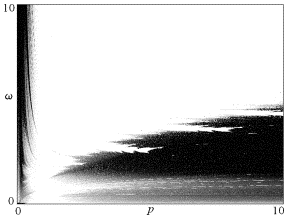Simplest Driven Conservative Chaotic Oscillator
H. P. W. Gottlieb
School of Science, Griffith University, Nathan, Queensland 4111,
Australia
J. C. Sprott
Department of Physics, University
of Wisconsin, Madison, WI 53706, USA
(Received 21 August 2001: received in revised form 2 November 2001;
accepted 2 November 2001)
ABSTRACT
Sinusoidally driven oscillator equations with a power-law nonlinearity
are investigated computationally to determine the driving frequency which
produces the "most chaos", i.e., the maximixed largest Lyapunov exponent.
It is argued that the "simplest" such driven chaotic oscillator has a cubic
nonlinearity x3.
Ref: H. P. W. Gottlieb and J. C. Sprott, Phys.
Lett. A 291, 385-388 (2001)
The complete paper is available in PDF format.
Return to Sprott's Books and Publications.
Fig. 1. Largest Lyapunov exponent lambda versus driving angular
frequency omega for Eq. (1) with p=3.
![[Figure 1]](265fig1.gif)
Fig. 2. Poincaré section in the x-dx/dt plane for
p=3,
omega=1.88
case of Eq. (1), for omega t mod 2pi=0.
![[Figure 2]](265fig2.gif)
Fig. 3. As for Fig. 1, but with p=5.
![[Figure 3]](265fig3.gif)
Fig. 4. Largest positive Lyapunov exponent for arbitrary p and
in Eq. (1), shown on a grey scale--blacker
tone for larger exponent.

![[Figure 1]](265fig1.gif)
![[Figure 2]](265fig2.gif)
![[Figure 3]](265fig3.gif)
